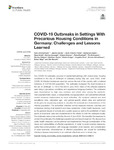COVID-19 Outbreaks in Settings With Precarious Housing Conditions in Germany: Challenges and Lessons Learned
Zimmermann, Ruth
Sarma, Navina
Thieme-Thörel, Doris
Alpers, Katharina
Artelt, Tanja
Azouagh, Karima
Bremer, Viviane
Broistedt, Petra
Eckmanns, Tim
Feltgen, Nicolas
Huska, Matthew
Kröger, Stefan
Puls, Angelika
Scheithauer, Simone
Mayr, Eckart
Rexroth, Ute
Two COVID-19 outbreaks occurred in residential buildings with overcrowded housing
conditions in the city of Göttingen in Germany during May and June 2020, when
COVID-19 infection incidences were low across the rest of the country, with a national
incidence of 2.6/100,000 population. The outbreaks increased the local incidence in
the city of Göttingen to 123.5/100,000 in June 2020. Many of the affected residents
were living in precarious conditions and experienced language barriers. The outbreaks
were characterized by high case numbers and attack rates among the residents,
many asymptomatic cases, a comparatively young population, and substantial outbreak
control measures implemented by local authorities. We analyzed national and local
surveillance data, calculated age-, and gender-specific attack rates and performed
whole genome sequencing analysis to describe the outbreak and characteristics of the
infected population. The authorities’ infection control measures included voluntary and
compulsory testing of all residents and mass quarantine. Public health measures, such
as the general closure of schools and a public space as well as the prohibition of team
sports at local level, were also implemented in the district to limit the outbreaks locally.
The outbreaks were under control by the end of June 2020.We describe themeasures to
contain the outbreaks, the challenges experienced and lessons learned.We discuss how
public health measures can be planned and implemented through consideration of the
needs and vulnerabilities of affected populations. In order to avoid coercive measures,
barrier-free communication, with language translation when needed, and consideration
of socio-economic circumstances of affected populations are crucial for controlling
infectious disease transmission in an outbreak effectively and in a timely way.

